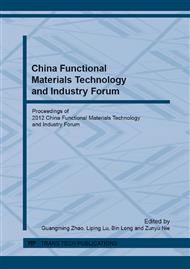p.241
p.251
p.255
p.259
p.265
p.270
p.275
p.281
p.287
Hydrothermal Synthesis of Nano-γ-MnOOH Using Complexes
Abstract:
The paper gains a new method for the synthesis of γ-MnOOH crystals by adding ethylenediamine metal complexes under hydrothermal conditions. Study the effect of different preparation process to the reaction products .The structure and morphology of the resultant products were characterized by using XRD, SEM. The results show that the product is α-MnO2 when did not join the ethylenediamine metal complexes and the product is γ-MnOOH when joined the ethylenediamine metal complexes in 100°C under hydrothermal conditions. The purity of the γ-MnOOH is not the same when adding different ethylenediamine metal complexes. Inorganic salts will reduce the purity of the product and a new Mn3O4 crystal can be prepared by increasing the reaction temperature to 180°C.
Info:
Periodical:
Pages:
265-269
Citation:
Online since:
May 2013
Authors:
Keywords:
Price:
Сopyright:
© 2013 Trans Tech Publications Ltd. All Rights Reserved
Share:
Citation:


